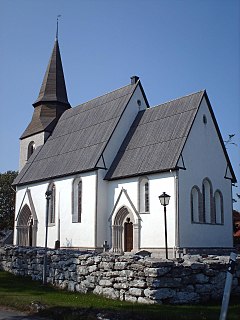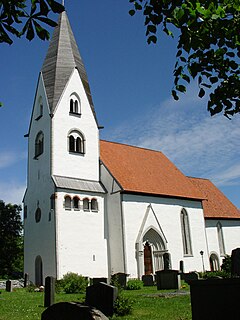
Väskinde is a locality on the Swedish island of Gotland.

Bäl is a populated area, a socken, on the Swedish island of Gotland. It comprises the same area as the administrative Bäl District, established on 1 January 2016.

Fole is a populated area, a socken, on the Swedish island of Gotland. It comprises the same area as the administrative Fole District, established on 1 January 2016.

Grötlingbo is a populated area, a socken, on the Swedish island of Gotland. It comprises the same area as the administrative Grötlingbo District, established on 1 January 2016.

Lokrume is a populated area, a socken, on the Swedish island of Gotland. It comprises the same area as the administrative Lokrume District, established on 1 January 2016.

Martebo is a populated area, a socken, on the Swedish island of Gotland. It comprises the same area as the administrative Martebo District, established on 1 January 2016.

Alva is a populated area, a socken, on the Swedish island of Gotland. It comprises the same area as the administrative Alva District, established on 1 January 2016.

Akebäck is a populated area, a socken, on the Swedish island of Gotland. It comprises the same area as the administrative Akebäck District, established on 1 January 2016.

Ardre is a populated area, a socken, on the Swedish island of Gotland. It comprises the same area as the administrative Ardre District, established on 1 January 2016. It is most noted for the Viking Ardre image stones found under the floor boards of the Ardre Church.

Hamra is a populated area, a socken, on the Swedish island of Gotland. It comprises the same area as the administrative Hamra District, established on 1 January 2016.

Stenkumla is a populated area, a socken, on the Swedish island of Gotland. It comprises the same area as the administrative Stenkumla District, established on 1 January 2016.

Sundre is a populated area, a socken, on the Swedish island of Gotland. It comprises the same area as the administrative Sundre District, established on 1 January 2016.

Rone is a populated area, a socken, on the Swedish island of Gotland. It comprises the same area as the administrative Rone District, established on 1 January 2016.

Vänge is a populated area, a socken, on the Swedish island of Gotland. It comprises the same area as the administrative Vänge District, established on 1 January 2016.

Väte is a populated area, a socken, on the Swedish island of Gotland. It comprises the same area as the administrative Väte District, established on 1 January 2016.

Hörsne-Bara is a populated area, a socken, on the Swedish island of Gotland. Formerly two sockens, Hörsne and Bara, Bara was merged with Hörsne under the name Hörsne socken or Hörsne with Bara socken. It comprises the same area as the administrative Hörsne-Bara District, established on 1 January 2016.

Garde or Garda is a populated area, a socken, on the Swedish island of Gotland. It comprises the same area as the administrative Garde District, established on 1 January 2016. It was the birth place of the marine biologist Adolf Appellöf (1857).

Gothem is a populated area, a socken, on the Swedish island of Gotland. It comprises the same area as the administrative Gothem District, established on 1 January 2016.

Boge is a populated area, a socken, on the Swedish island of Gotland. It comprises the same area as the administrative Boge District, established on 1 January 2016.

Hejnum is a populated area, a socken, on the Swedish island of Gotland. It comprises the same area as the administrative Hejnum District, established on 1 January 2016.


























